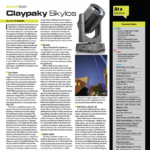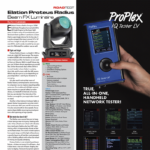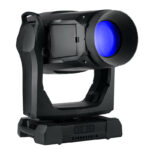So-called digital lights have long tantalized both gear manufacturers and designers alike. The allure of being able to project any image, media clip, text, or anything else designers dream up is a powerful one, as it represents a design tool of immense potential. The technology has proved stubbornly elusive to get right however, with efforts hampered by expense and thermal management issues. With the new eMotion, Elation Professional takes on these hurdles in a compact and efficient moving head package aimed at the corporate AV, exhibition, theatrical, house of worship and club market.
Challenges and Trade-Offs
The unit follows a standard moving head form factor, with the head being slightly flatter and box-like to accommodate the projection electronics, with the final output lens slightly offset from center. The unit is roughly on the same scale as other 250-watt moving head units, with an output similar to larger moving head projectors. Immediately behind the exterior protection glass is a mechanical shutter that closes when the dimmer level is at 0 percent to prevent the “video black” output square from showing, especially valuable in “black box” applications, or any time seeing the units would damage the effect.
Inside the head is a stock Benq DLP projector outfitted with outboard control for lamp, zoom and focus functions. This projector has a native resolution of 1024×768, with an aspect ratio of 4:3, though media of any ratio can be displayed. The light source here is an Osram 240W lamp. This style of lamp has a very short arc and is commonly encountered in projectors, and comes pre-focused in its housing. These lamps also have some very specific cooling requirements, so there’s a large fan on the front of the projector to force air into the head, as well as some fancy ductwork inside. To change the lamp, users remove the top head cover, slide open a panel on the projector and remove the lamp, which is held in place with two leads and a single captive screw. The whole process is somewhat finicky, so it is not a task that I would attempt while the unit is in the air.
I measured the full output of the light in open white as 645 lux at five meters. This output, in my opinion, is likely to be somewhat limiting when considering potential applications, but moving-head projectors of this type have always been limited in terms of output due to the trade-offs imposed by the display technology, cooling, lamp wattage, and available space inside the head. That said, one advantage here is that because the color mix system adds nothing extra to the optical train, the unit does not suffer from the same drop in output that a CMY mix system would. The dimmer curve is very smooth and closely follows an ideal square curve. Elation describes the fixture as having a 1.1:1 optical zoom range; most of the zoom here is digital. The unit lets users zoom narrower than the optical zoom by essentially resizing images down. One consequence of this is that, when zoomed down, the image will lose brightness, because less of the “screen” is being devoted to the image. Focus quality was excellent, with nice sharp edges over the entire image.
There is no optical system here other than what’s the in the projector, so all alterations to output are done digitally. Color in DLP projectors is accomplished with a high-RPM rotating wheel with colored dichroic filters on it, and the projector Elation has chosen uses somewhat unsaturated colors. The red and green, in particular, are quite pale. All color systems are a trade-off between saturation and brightness, and Elation prioritized brightness here. Users will need to be aware of the characteristics of this system in order to understand how any media they upload will look upon output.
Video and Gobo Output
For graphics output, the fixture operates with two layers. Each layer consists of two components: a video component and a still image “gobo” component. The unit comes with a pre-installed library of 255 royalty-free moving backgrounds, and the entire Elation gobo library for the still image component. Using the CMY / RGB controls, the user can color the gobo, and it can also be both indexed and rotated as in any other moving light. The video component of a layer indexes and rotates along with the gobo; there is no way to separate them.
Elation has a good mix of moving backgrounds included with the light, there are a nice variety of moving geometric shapes, textured fills, lines, and other elements. Some of these are clearly designed for aerial projection effects and others would work best for texture projection on a surface. The gobo library is extensive, and being able to layer gobos on top of the video component lets you create some interesting visuals. There are plenty of built-in transitions for going between the layers, including dissolves, wipes, bars, and others, as well as variety of blending modes and media effects for manipulating the content on the light. In my testing, I noticed some minor frame rate drops when running certain effects on both layers. In an ideal scenario, all video manipulations should be done at a content level. All of the media is stored on an internal 64GB flash storage hard drive. This drive has a solid-state design, which should improve its reliability and resistance to shock caused by transport and handling. Users can upload their own media and content through the Elation CMA (Content Management Application), which is available for Windows only. The application was easy to use, though it may be necessary to adjust the computer’s network settings to allow the application to network with the lights.
The unit also includes a feature Elation calls “Collage Generator.” It comes into play when using arrays of up to twelve lights and gives the user full edge-blending capability. You can either “slice” your content up before importing, or all of the lights in the array can work from the same graphic and project only a small part of it. Which method you choose will depend on the situation, and it’s nice to have this capability built into the unit instead of needing an external media server to accomplish the same effect. (As I only had one unit, I was unable to test this capability.) In extended mode, the unit also includes full keystoning capability to correct for projection angles that are less than straight on.
Construction is as expected, with a plastic shell over an aluminum and steel chassis. Power is provided via Neutrik TRUE1 ins and throughs, and the fixture auto-ranges from 100-240VAC. Data is accepted via 5-pin DMX or via Art-Net on the built-in Ethernet ports, and rigging is via two of the now-familiar Omega-style brackets on the bottom of the fixture. Total weight is 44 pounds, with a pan and tilt range of 540º and 270º, respectively. The front lens incorporates High End System’s “lens defogger” — a heating system for the front output lens that HES says helps evaporate any moisture build-up, including haze.
At a Glance
Complex Challenge, Simple Solution
The Elation eMotion goes up against some very difficult engineering challenges characteristic of all moving-head projectors, and where it succeeds the most is in the simplicity of the system — just load your content and go, no external media server needed. The versatility of being able to project custom content — as well as upload it very quickly — is an obvious asset in any situation where moving projection is needed. The eMotion is likely to shine its brightest in museums, corporate presentations, clubs, and houses of worship — anywhere fast and easy media display is needed.
Elation eMotion
PROS: Compact, onboard edge-blend and collage capability
CONS: Limited brightness, saturation of certain colors
Stats
Size / Weight
- Length: 18.9” (480mm)
- Width: 15.0” (382mm)
- Vertical Height: 22.4” (569mm)
- Weight: 44.0 lbs. (20 kg)
Electrical / Thermal
- AC 100-240V – 50/60Hz
- 350W Max Power Consumption
- 40° – 95°F (5° – 35°C)
Approvals / Ratings
- CE | IP20
MSRP: $9,999.95
Manufacturer: Elation Professional
More Info: www.elationlighting.com



